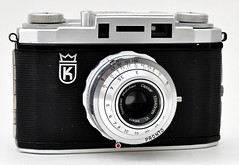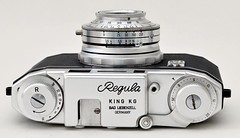Difference between revisions of "Regula IId"
Hanskerensky (talk | contribs) (Added image author and rights scripts) |
(added year category) |
||
| (10 intermediate revisions by 4 users not shown) | |||
| Line 4: | Line 4: | ||
|- | |- | ||
| style="font-size: 95%;" | | | style="font-size: 95%;" | | ||
| − | |||
| − | |||
'''Manufacturer:''' [[King]] | '''Manufacturer:''' [[King]] | ||
| − | '''Date of Production:''' | + | '''Date of Production:''' 1954-56 |
'''Type of Camera:''' Uncoupled Rangefinder | '''Type of Camera:''' Uncoupled Rangefinder | ||
| − | |||
'''[[Film]] Type:''' 35mm | '''[[Film]] Type:''' 35mm | ||
| Line 28: | Line 25: | ||
'''[[ASA|ASA/ISO range]]:''' 8-200 | '''[[ASA|ASA/ISO range]]:''' 8-200 | ||
| + | {{Flickr image | ||
| + | | image_source=http://www.flickr.com/photos/10456228@N00/4609237056/in/pool-camerawiki | ||
| + | | image=http://farm4.static.flickr.com/3310/4609237056_a6155b3f08_m.jpg | ||
| + | | image_align=center | ||
| + | |image_by=Morinaka. | ||
| + | |image_rights= with permission | ||
| + | }} | ||
| + | |||
| + | {{Flickr image | ||
| + | | image_source=http://www.flickr.com/photos/10456228@N00/6887673309/in/pool-camerawiki | ||
| + | | image=http://farm8.staticflickr.com/7181/6887673309_0ca87d89e1_m.jpg | ||
| + | | image_align=center | ||
| + | | image_text=[[Regula]] IId - Top section | ||
| + | |image_by=Morinaka. | ||
| + | |image_rights= with permission | ||
| + | }} | ||
| + | |} | ||
| + | |||
| + | The '''Regula IId''' is a [[35mm]] uncoupled rangefinder camera made at Bad Liebenzell in the Black Forest by [[King|King KG]] from 1954-56 as a part of their [[Regula]] brand. | ||
| + | |||
| + | The construction of the camera is mostly metal, the only plastic (maybe [[Bakelite]]) part is the film take-up; the camera feels very solid but not that heavy like the previous Regula I models. The film is [[film advance|advanced]] with a lever on the top of the camera. Advancing the film also cocks the shutter, an improvement upon earlier Regula models which required manual cocking. If the film frame is removed from inside the camera, the cocking mechanism can be seen; it is achieved by a watch chain connected just above the film take-up to a spring-loaded ratchet on the other side of the camera. | ||
| + | |||
| + | The film counter is under the film advance and will only count when there is film in the camera. When rewinding film the counter goes backwards; a good way to tell if the film has been fully rewound (it will also stop clicking once it has comes off the spool). The counter is driven via a toothed wheel that sits in the film perforations; it is also connected to a latch and will prevent the shutter from firing until the counter has increased by one. The film is rewound with a knob on the other side of the top plate. A button on the bottom of the camera must be pressed while rewinding. | ||
| + | |||
| + | The lens is a [[Steinheil|Cassar]] type (three element [[anastigmat]]) and goes from f/3.5 through to f/16. The shutter is a bit more basic with only 4 speeds and a bulb setting. The camera does have a 10 second [[self-timer]] using a lever under the lens. There is a PC [[flash sync]] point on the left side of the lens housing. | ||
| + | |||
| + | The camera has a built in rangefinder but it isn't coupled to the lens. It is controlled with a dial under the film rewind. Also sold as the '''Azore V'''.<ref>{{McKeown12}} Page 808.</ref><!--''commented out - not sure what is meant:'' The viewfinder itself is collimated but with no frame lines to help guide you.--> | ||
| + | |||
| + | === Extinction Meter Guide === | ||
| + | The camera has a built in [[Light_meter#Extinction_Meters|extinction meter]] that is viewed through a separate window on the rear of the camera. To use the meter, look through the meter eyepiece with the camera pointing towards the subject. Note the last still well defined number on the scale and use this number on the table below to work out the exposure. When using the meter it is recommended to shield it from direct sunlight by using your hand as a shade above the camera. | ||
| + | |||
| + | This table was originally for ISO/ASA 40 film but is here converted it for use with ISO 100 film. Times below 1 second would have to be done in bulb mode. The numbers can also be roughly converted to EV values for easier calculation. Using ISO 100 film, number 1 on the scale works out to EV 8 and number 8 on the scale works out to EV 15. | ||
| + | |||
| + | {|class="collapsible" cellpadding="5px" cellspacing="2" style="text-align: center; padding: 3px;" | ||
| + | |- bgcolor=#E0E0E0 | ||
| + | | colspan=1 | Aperture | ||
| + | | colspan=8 | Exposure Table for Extinction Meter (ISO 100) | ||
| + | |- bgcolor=#E0E0E0 | ||
| + | ! | ||
| + | !1 | ||
| + | !2 | ||
| + | !3 | ||
| + | !4 | ||
| + | !5 | ||
| + | !6 | ||
| + | !7 | ||
| + | !8 | ||
| + | |- bgcolor=#F0F0F0 | ||
| + | !bgcolor=#E0E0E0|f/2.8 | ||
| + | |1/25||1/50||1/100||1/200|| - || - || - || - | ||
| + | |- bgcolor=#F0F0F0 | ||
| + | !bgcolor=#E0E0E0|f/3.5 & 4 | ||
| + | |1/10||1/25||1/50||1/100||1/200|| - || - || - | ||
| + | |- bgcolor=#F0F0F0 | ||
| + | !bgcolor=#E0E0E0|f/5.6 | ||
| + | |1/5||1/10||1/25||1/50||1/100||1/200|| - || - | ||
| + | |- bgcolor=#F0F0F0 | ||
| + | !bgcolor=#E0E0E0|f/8 | ||
| + | |1/2||1/5||1/10||1/25||1/50||1/100||1/200|| - | ||
| + | |- bgcolor=#F0F0F0 | ||
| + | !bgcolor=#E0E0E0|f/11 | ||
| + | |1s||1/2||1/5||1/10||1/25||1/50||1/100||1/200 | ||
| + | |- bgcolor=#F0F0F0 | ||
| + | !bgcolor=#E0E0E0|f/16 | ||
| + | |2s||1s||1/2||1/5||1/10||1/25||1/50||1/100 | ||
| + | |- bgcolor=#F0F0F0 style="font-weight: bold;" | ||
| + | !bgcolor=#E0E0E0|EV Number | ||
| + | |8||9||10||11||12||13||14||15 | ||
|} | |} | ||
| − | |||
| − | |||
| − | |||
| − | == | + | ==Notes== |
| − | + | <references/> | |
| + | [[Category: King]] | ||
[[Category: R]] | [[Category: R]] | ||
| − | [[Category:German 35mm viewfinder]] | + | [[Category: Regula]] |
| + | [[Category: German 35mm rangefinder]] | ||
| + | [[Category: German 35mm viewfinder]] | ||
| + | [[Category:1954]] | ||
Latest revision as of 06:27, 7 April 2018
| Regula IId | ||||
|---|---|---|---|---|
|
Manufacturer: King Date of Production: 1954-56 Type of Camera: Uncoupled Rangefinder Film Type: 35mm Lens: Steinheil Munchen Cassar 40mm f/3.5 VL Shutter speed range: 1/25-1/200th + B Focus areas: 1m-Infinity Viewfinder: Yes ASA/ISO range: 8-200
|
The Regula IId is a 35mm uncoupled rangefinder camera made at Bad Liebenzell in the Black Forest by King KG from 1954-56 as a part of their Regula brand.
The construction of the camera is mostly metal, the only plastic (maybe Bakelite) part is the film take-up; the camera feels very solid but not that heavy like the previous Regula I models. The film is advanced with a lever on the top of the camera. Advancing the film also cocks the shutter, an improvement upon earlier Regula models which required manual cocking. If the film frame is removed from inside the camera, the cocking mechanism can be seen; it is achieved by a watch chain connected just above the film take-up to a spring-loaded ratchet on the other side of the camera.
The film counter is under the film advance and will only count when there is film in the camera. When rewinding film the counter goes backwards; a good way to tell if the film has been fully rewound (it will also stop clicking once it has comes off the spool). The counter is driven via a toothed wheel that sits in the film perforations; it is also connected to a latch and will prevent the shutter from firing until the counter has increased by one. The film is rewound with a knob on the other side of the top plate. A button on the bottom of the camera must be pressed while rewinding.
The lens is a Cassar type (three element anastigmat) and goes from f/3.5 through to f/16. The shutter is a bit more basic with only 4 speeds and a bulb setting. The camera does have a 10 second self-timer using a lever under the lens. There is a PC flash sync point on the left side of the lens housing.
The camera has a built in rangefinder but it isn't coupled to the lens. It is controlled with a dial under the film rewind. Also sold as the Azore V.[1]
Extinction Meter Guide
The camera has a built in extinction meter that is viewed through a separate window on the rear of the camera. To use the meter, look through the meter eyepiece with the camera pointing towards the subject. Note the last still well defined number on the scale and use this number on the table below to work out the exposure. When using the meter it is recommended to shield it from direct sunlight by using your hand as a shade above the camera.
This table was originally for ISO/ASA 40 film but is here converted it for use with ISO 100 film. Times below 1 second would have to be done in bulb mode. The numbers can also be roughly converted to EV values for easier calculation. Using ISO 100 film, number 1 on the scale works out to EV 8 and number 8 on the scale works out to EV 15.
| Aperture | Exposure Table for Extinction Meter (ISO 100) | |||||||
| 1 | 2 | 3 | 4 | 5 | 6 | 7 | 8 | |
|---|---|---|---|---|---|---|---|---|
| f/2.8 | 1/25 | 1/50 | 1/100 | 1/200 | - | - | - | - |
| f/3.5 & 4 | 1/10 | 1/25 | 1/50 | 1/100 | 1/200 | - | - | - |
| f/5.6 | 1/5 | 1/10 | 1/25 | 1/50 | 1/100 | 1/200 | - | - |
| f/8 | 1/2 | 1/5 | 1/10 | 1/25 | 1/50 | 1/100 | 1/200 | - |
| f/11 | 1s | 1/2 | 1/5 | 1/10 | 1/25 | 1/50 | 1/100 | 1/200 |
| f/16 | 2s | 1s | 1/2 | 1/5 | 1/10 | 1/25 | 1/50 | 1/100 |
| EV Number | 8 | 9 | 10 | 11 | 12 | 13 | 14 | 15 |
Notes
- ↑ McKeown, James M. and Joan C. McKeown's Price Guide to Antique and Classic Cameras, 12th Edition, 2005-2006. USA, Centennial Photo Service, 2004. ISBN 0-931838-40-1 (hardcover). ISBN 0-931838-41-X (softcover). Page 808.

